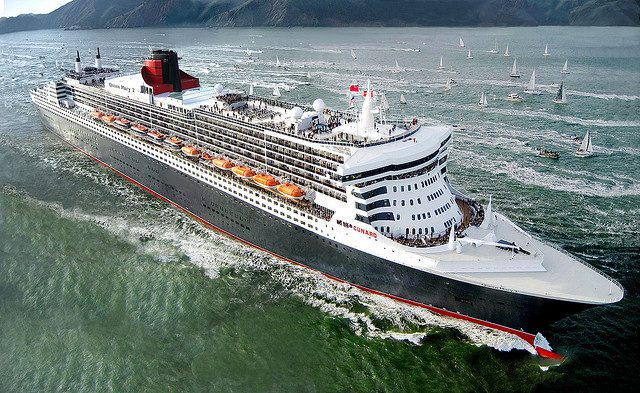Cunard Line’s Queen Mary 2 navigating in a busy harbor
by Captain Grant H Livingstone
Part Two out of Three Part articles on COLREGS.
Are some professional mariners unintentionally violating COLREGS in a conscientious effort to avoid close quarters situations with small boats? A review a few of the most common violations professional mariners are being found at fault for or debate in inland waters with small boats is worthy of discussion.
The first is the classic crossing situation Rule 15; “When two power driven vessels are crossing so as to involve risk of collision the vessel which has the other on her starboard side shall keep out of the way and shall if the circumstances of the case permit avoid crossing ahead of the other vessel.” The obligation of the stand on vessel triggers Rule 17(c). In brief a power driven vessel which takes action in a crossing situation to avoid collision shall if the circumstances of the case permit not alter course to port for a vessel on her own port side.
This is very common in inland waters as small power boats (or sailboats) on the ships port bow are not yielding or giving way in a crossing situation. The small boat appears to be set on crossing the ships bow port to starboard. This is where professional mariners Prudent Seamanship (common sense on the water) kicks in. If there really is a risk of hitting the small boat (crossing our bow from port) by maintaining our course as stand on vessel, then altering course to starboard might increase the risk of collision…..depending on the circumstances. By altering course to starboard, we potentially chase the small boat crossing our bow to starboard.
Therefore many professional mariners may see a turn to port (common sense) as the most expedient and safest way to clear the small boat heading to our starboard. We’ll pass astern of the give way vessel to avoid collision if they won’t give way. The fatal flaw in that common sense view is when the small boat gives way at the very last second and turns to their starboard or stops to avoid crossing our bow. In that case, small boat giving way off our port bow, the odds of collision go up dramatically if we turned our ship to port.
In case after case the professional mariner that turned to port to avoid a small boat crossing to starboard from its port bow (violating Rule 17(c)) are found at fault. Very similar is Rule 19 under Conduct of Vessels in Restricted Visibility; Rule 19(i) an alteration of course to port for a vessel forward of the beam other than a vessel being overtaken ….. shall be avoided.
Mariners often find themselves trying to outguess the small boat crossing their bow. If we are the stand on vessel at what point do we give way? Any decision based on “outguessing” falls under the COLREGS admonishment not to make decisions based on scanty information. Rule 17(b) ends with; If collision cannot be avoided by the action of the give way vessel alone, she (stand on vessel) shall take such action as will best aid to avoid collision. The professional mariner shall take action to avoid collision but it cannot be a turn to port for a vessel off the port bow.
In part three of this series we look into what may be the Grand Daddy of COLREG debate and interpretation among professional mariners; Rule 34. Traditionally referred to as the ‘Danger Signal’.
Next: Read Part 1 of this series: Are Ships The Careless Giants Of The Sea?

 Join The Club
Join The Club











